Essaouira is known for its coastal charm and distinctive tranquility, but it’s also a city with a rich history manifested through historical landmarks scattered among its walls, port, and beaches. This enchanting city, formerly known as “Mogador,” carries stories from the past and a diverse heritage worth exploring.
In this guide, we’ll take you on a tour to discover the most prominent historical landmarks in Essaouira, from its beating heart—the Medina and its walls—to the vibrant port of Essaouira, passing through its diverse religious heritage including mosques, synagogues, a mausoleum, and even Christian monuments, not forgetting the beauty of the coast and beaches that form an integral part of this wonderful Moroccan city’s identity.
The Medina and Its Ramparts in Essaouira: The Heart of the City and UNESCO Heritage
The Medina of Essaouira, listed as a UNESCO World Heritage site, is the historical heart of the city and home to its most important landmarks and defensive walls that reflect the essence of history and authentic Moroccan architecture.
The Medina (Kasbah): Wandering Through Enchanting Alleys
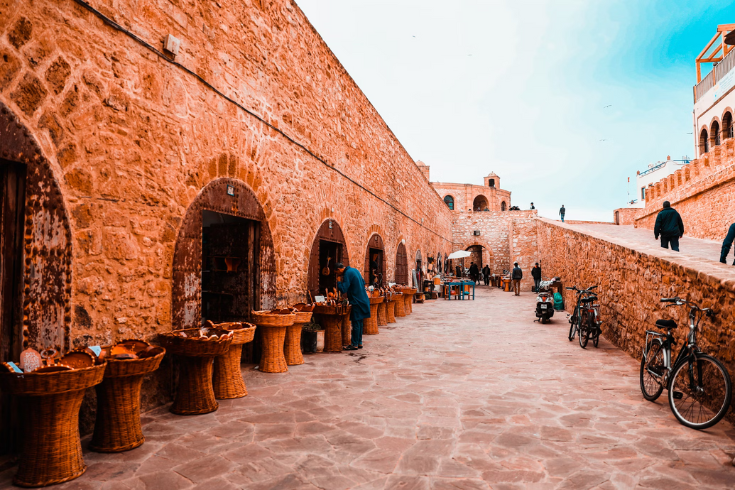
The Medina of Essaouira is characterized by its peaceful atmosphere compared to other ancient cities like Fez and Marrakech, where whitewashed buildings with blue accents give the place a unique maritime character. The narrow, winding alleys house art galleries and traditional shops displaying local crafts, especially those made from the famous thuya wood. The term “Kasbah” generally refers to a historically fortified section within or adjacent to the Medina, particularly near the sea.
The City Walls: Defense and Panoramic Views
The city walls in Essaouira are among the most prominent historical landmarks, built mainly in the 18th century during the Alaouite era, with clear European influences. These walls were designed to protect the city from maritime raids and surround the Medina almost completely, making them a testament to the military engineering of the time. Visitors can walk on parts of these walls and enjoy spectacular panoramic views of the Atlantic Ocean and the city.
Borj El Basha (Skala de la Kasbah) and Skala du Port
Borj El Basha, also known as “Skala de la Kasbah,” is one of Essaouira’s most famous historical landmarks. It’s a fortified platform located inside the Medina equipped with ancient cannons pointing toward the sea and the island. This tower offers stunning views that make it a major tourist attraction in the city. The “Skala du Port,” meanwhile, is located near the port and offers different but equally magnificent views. These cannons and spectacular views are among the most important features of these historical landmarks in Essaouira.
The Port of Essaouira: A Vibrant Maritime History
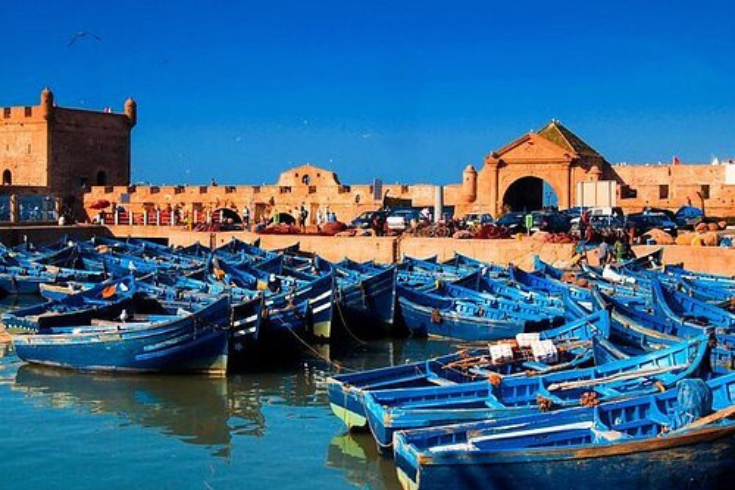
The port of Essaouira is more than just a fishing port; it’s a witness to the city’s commercial and maritime history and continues to pulse with life and activity, making it one of the most important historical landmarks in the city.
The Atmosphere of Essaouira’s Port: Blue Boats, Fishermen, and Seagulls
Essaouira’s port is characterized by its distinctive blue boats that line up in a unique visual scene, and the daily activity of fishermen that begins from the first hours of dawn. The bustling fish market is one of the most vibrant places where various types of fresh fish are displayed for sale. Seagulls hovering above the port add a magical touch to the place, while the smell of the sea and fresh fish fills the air.
The Historical Role of the Port
The port of Essaouira played an important historical role in the 18th and 19th centuries as a major commercial port connecting Morocco to Europe and the rest of the world. It was established by Sultan Sidi Mohammed ben Abdallah as part of his vision to develop the city and enhance Moroccan maritime trade. Today, visitors can walk around the port and observe the daily activity, even purchase fresh fish to be grilled at nearby restaurants, as well as visit the Skala du Port.
The Diverse Religious Heritage in Essaouira: A Testament to Historical Coexistence
Essaouira is characterized by a long history of coexistence between different religions, which is reflected in its religious landmarks that include mosques, synagogues, a mausoleum, and even Christian remnants, forming an important part of the historical landmarks in Essaouira.
The Grand Mosque and Zaouia of Sidi Mimoun (Islamic Heritage)
The Grand Mosque is one of the most prominent Islamic monuments in the Medina of Essaouira and an important religious center for locals. The Zaouia of Sidi Mimoun is a Sufi site that is highly respected. It should be noted that these sites are usually restricted to Muslims only, but non-Muslim visitors can admire their architecture from the outside.
Jewish Heritage: The Mellah, the Synagogue, and the Mausoleum
The Mellah of Essaouira (the historical Jewish Quarter) is an important part of the city’s history, which once housed a large proportion of Jewish residents. The Simon Attias Synagogue, located within the Mellah, is a prominent historical landmark that has been restored and can be visited as a museum and historical site. The Mausoleum of Rabbi Haim Pinto, located outside the Medina walls, is considered an important pilgrimage site. These monuments reflect Essaouira’s history as a city that housed a large Jewish community. The synagogue and mausoleum can be visited at specific times.
Christian Monuments (such as the Portuguese Church)
Although fewer in number, Christian monuments in Essaouira testify to the historical presence of Christian communities, especially during the period of Portuguese influence. These landmarks include the remains of the Portuguese church, historical buildings, and cemeteries that mark this history. These sites are often ruins or simple churches not regularly open for visits.
Other Historical and Cultural Buildings
Besides religious landmarks and fortifications, Essaouira also houses other historical buildings of cultural importance that add to the list of historical landmarks in Essaouira.
Dar Souiri
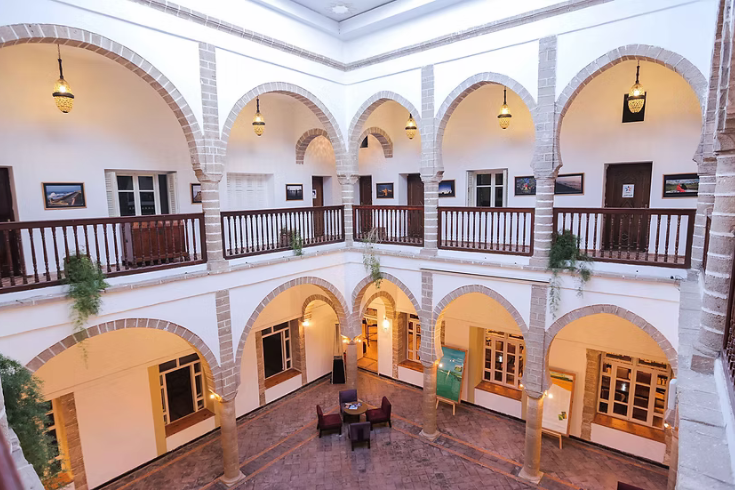
Dar Souiri is one of the beautiful historical buildings in the city, now transformed into a cultural center hosting events, exhibitions, and Gnawa music performances. It is distinguished by its remarkable traditional architecture and is considered a living example of Essaouira’s historical houses.
The Coast and Beaches in Essaouira: Nature, Wind, and History
The coast and beaches are an integral part of Essaouira’s identity and tourist appeal, offering a different experience from exploring the historical landmarks inside the walls.
The Beauty of the Coast and Beach Activities
Essaouira’s long sandy beaches stretch southward, known for their strong winds that make them an ideal destination for surfing and kitesurfing, earning it the nickname “City of Wind.” The unique atmosphere on the beach with seabirds and vast open spaces, as well as the possibility of camel or horse rides, makes visiting the coast an unforgettable experience.
Historical Views from the Coast
From the beach, visitors can enjoy stunning views of the city walls and the historical islands close to the shore (including remnants of the old Portuguese fort on the island). This angle offers a unique opportunity to see Essaouira’s historical landmarks from a different perspective.
Visiting the Historical Landmarks in Essaouira: A Practical Guide and Important Tips
To explore the historical landmarks in Essaouira and enjoy their beauty, here are some practical tips for getting around and exploring.
Getting Around Essaouira
The Medina of Essaouira is relatively small, and walking is the best way to see most sites. Small taxis can be used to access external sites such as the Mausoleum of Rabbi Haim Pinto or to reach more distant parts of the beach.
Opening Hours and Entrance Fees (for Visitable Sites)
Walking through the alleys of the Medina, on the walls (Skalas), at the port, and on the beaches is free and accessible most of the day. However, certain sites like Dar Souiri or the Simon Attias Synagogue may have specific opening hours and entrance fees. It is advisable to check specific sites before visiting.
Visitation Rules and Behavior (Especially for Religious Sites)
It is recommended to wear modest clothing when visiting or passing by religious sites (mosques, synagogues, zaouias, mausoleums). Also, be aware of prayer times near mosques. It is preferable to ask permission before photographing people, especially in the port or local areas.
The best time to visit Essaouira is in spring and autumn when the weather is pleasant, knowing that winds can be strong year-round. Summer is popular but usually windy. Regarding time of day, the port is active in the morning and late afternoon, while watching the sunset from the Skalas is an unforgettable experience.
It’s worth noting that the Medina of Essaouira is less complex than Fez or Marrakech, making it easier to navigate, but “getting pleasantly lost” is still part of its charm.
Conclusion: Essaouira… A City of History, Spirituality, and Beauty on the Coast
The historical landmarks in Essaouira are distinguished by their diversity and unique charm, from the fortified Medina and its walls to the port of Essaouira, through its diverse religious heritage and the beauty of the coast and beaches. Each of these sites contributes to building the unique character of this charming coastal city.
Exploring these historical landmarks offers visitors a chance to connect deeply with Essaouira’s layered history and vibrant present. We encourage you to use this guide to plan your visit to explore Essaouira’s historical landmarks, share the article, and share your own experiences or favorite spots with others.
Have you visited Essaouira before? What is your favorite historical landmark in this enchanting city? Share your experiences in the comments!



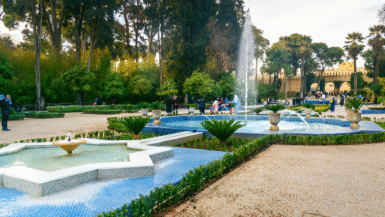
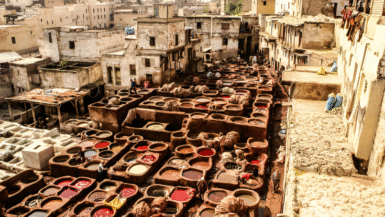
Leave a reply